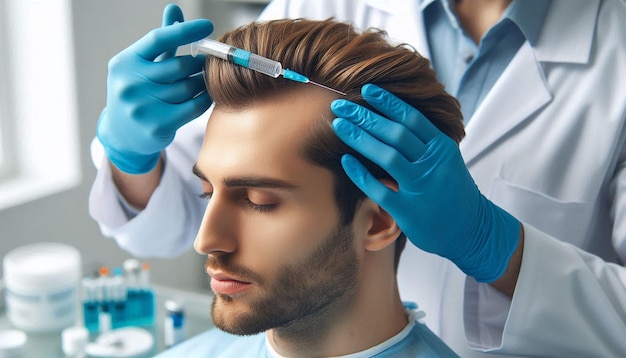Platelet-Rich Plasma (PRP) therapy has emerged as an innovative treatment for hair loss, drawing significant attention from both medical professionals and individuals seeking to restore their hair. Rooted in the science of regenerative medicine, PRP involves harnessing the body's natural healing properties to stimulate hair growth. This article explores the underlying mechanisms, benefits, procedures, and what to expect from PRP Hair Treatment in Dubai.
Understanding Platelet-Rich Plasma
PRP is derived from a patient’s own blood and is rich in growth factors that are essential for healing and regeneration. The process begins with a simple blood draw, which is then processed through a centrifuge to separate the platelets from other blood components. This concentrated plasma is then reintroduced into the scalp, where it plays a vital role in stimulating hair follicles and encouraging new hair growth. The unique composition of PRP not only helps in healing but also activates dormant hair follicles, leading to revitalized hair production.
The Science of Hair Growth
Hair loss can be attributed to various factors, including genetics, hormonal changes, stress, and underlying medical conditions. At its core, hair growth is regulated by a cycle that includes the anagen (growth), catagen (transitional), and telogen (resting) phases. PRP therapy aims to influence the growth phase by delivering an abundance of platelets and their associated growth factors directly to the affected areas of the scalp. This targeted approach engages the hair follicles at a cellular level, promoting hair thickness and enhancing overall scalp health.
Who Can Benefit from PRP Therapy?
PRP therapy is not exclusive to any gender and can benefit a wide range of individuals suffering from various types of hair loss. It is particularly effective for those with androgenetic alopecia, commonly known as male or female pattern baldness. Moreover, individuals who have experienced hair loss due to stress, hormonal imbalances, or recent medical conditions may find PRP treatment beneficial. Age is not a limiting factor; studies indicate that individuals from their late teens to their seventies have successfully undergone PRP therapy to address hair thinning and loss.
The PRP Treatment Procedure
The PRP hair treatment procedure is minimally invasive and typically involves three main steps. First, a healthcare provider draws a small amount of blood, usually from the arm. Next, this blood is placed in a centrifuge, which spins it rapidly to separate the platelets from the red and white blood cells. The resulting platelet-rich plasma is then injected into the areas of the scalp experiencing hair thinning. The entire procedure usually takes about an hour, and most patients do not require any downtime, allowing them to resume normal activities immediately afterward.
Preparation for PRP Treatment
Preparation is crucial for maximizing the effectiveness of PRP therapy. Patients are generally advised to wash their hair thoroughly before the procedure to ensure a clean scalp. Staying hydrated and consuming a light meal beforehand can also help stabilize blood pressure during the blood draw. Patients are encouraged to avoid alcohol, smoking, and blood thinners in the days leading up to the treatment to ensure optimal platelet function.
Post-Treatment Care and Considerations
After receiving PRP injections, patients are given specific guidelines to promote healing and enhance results. It is typically suggested to avoid washing the hair for at least 24 hours to allow the PRP to settle into the scalp fully. Furthermore, patients should refrain from using hair products such as gels or sprays for several days. Some minor discomfort or swelling at the injection sites may occur, but these symptoms are usually temporary. Most importantly, patients should report any persistent side effects to their healthcare provider for further evaluation.
Expected Results and Efficacy
The results of PRP therapy can vary from individual to individual, depending on factors like the severity of hair loss, individual health conditions, and adherence to post-treatment care. While some patients may begin to notice visible improvements in hair density and texture within three to six months, others may take longer to respond. Continuous treatments, typically performed every four to six months, may be recommended to maintain and enhance results.
Safety and Side Effects
PRP therapy is considered safe when administered by trained healthcare professionals. Because it utilizes the patient’s own blood, the risk of allergic reactions or complications is significantly reduced. However, as with any medical procedure, minor side effects such as temporary swelling, redness, or irritation at the injection sites may occur. Serious complications are rare, but patients should always discuss their medical history with the provider to ensure suitability for the procedure.
Comparisons to Other Hair Loss Treatments
PRP therapy differs from other hair restoration options like hair transplants and topical treatments such as minoxidil (Rogaine). While hair transplants involve relocating hair follicles from denser areas to thinning areas, PRP therapy works to reactivate existing follicles without surgery. Topical treatments can be effective but often require daily application and may not yield the same regenerative benefits that PRP offers. Ultimately, PRP can be undertaken alone or in conjunction with other treatments to provide a comprehensive approach to hair restoration.
The Future of PRP Therapy
As research into PRP therapy continues to advance, growing evidence supports its role in treating various forms of hair loss. Ongoing studies are exploring its effectiveness when combined with other treatment modalities and the potential for broader applications beyond hair restoration. As the understanding of PRP technology evolves, more people may gain access to this promising therapeutic option.
Conclusion
Platelet-Rich Plasma therapy is not just a trend; it represents a significant leap forward in the treatment of hair loss. By utilizing the body’s own resources, PRP therapy presents a natural and effective way to combat thinning hair and stimulate growth. For those struggling with hair loss, understanding the benefits and procedures of PRP can empower them to make informed decisions about their hair restoration journey. With continuous advancements in research and technology, PRP stands as a beacon of hope for individuals looking to rejuvenate their hair and regain their confidence.





Comments